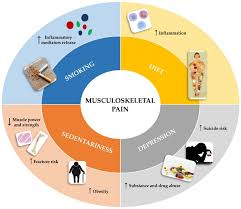Notifications
ALL BUSINESS
COMIDA
DIRECTORIES
ENTERTAINMENT
FINER THINGS
HEALTH
MARKETPLACE
MEMBER's ONLY
MONEY MATTER$
MOTIVATIONAL
NEWS & WEATHER
TECHNOLOGIA
TV NETWORKS
VIDEOS
VOTE USA 2026/2028
INVESTOR RELATIONS
DEV FOR 2025 / 2026
ALL BUSINESS
COMIDA
DIRECTORIES
ENTERTAINMENT
FINER THINGS
HEALTH
MARKETPLACE
MEMBER's ONLY
MONEY MATTER$
MOTIVATIONAL
NEWS & WEATHER
TECHNOLOGIA
TV NETWORKS
VIDEOS
VOTE USA 2026/2028
INVESTOR RELATIONS
DEV FOR 2025 / 2026
About Me
 Anna Lee
Anna Lee Greetings. I'm Anna Lee. I have been a medical health provider for 5 years. I provide different kinds of tablets to consumers via my website, HealthCurePills. You can get your medicine and purchase inexpensive medication from our pharmacy, HealthCurePills.
 Anna Lee -
Feb 18 -
Health -
Pain management
chronic pain
chronic pain relief
-
272 views -
0 Comments -
0 Likes -
0 Reviews
Anna Lee -
Feb 18 -
Health -
Pain management
chronic pain
chronic pain relief
-
272 views -
0 Comments -
0 Likes -
0 Reviews

Chronic pain and persistent pain symptoms affect millions of people worldwide. These conditions can disrupt daily life, making even simple tasks challenging. Understanding the causes, symptoms, and management strategies is crucial for those living with chronic pain. This guide provides a comprehensive overview to help you navigate the complexities of chronic pain.
Chronic pain lasts for months or even years. Unlike acute pain, which signals injury and fades as healing occurs, chronic pain persists. It often continues long after the initial injury or illness has healed. Chronic pain can stem from various conditions, including arthritis, fibromyalgia, and nerve damage.
Chronic pain arises from multiple sources. Injuries, surgeries, and infections can trigger it. Conditions like osteoarthritis, rheumatoid arthritis, and endometriosis are common culprits. Nerve damage, known as neuropathy, often leads to chronic pain. Psychological factors, such as stress and depression, can exacerbate the pain.
Chronic pain manifests in various ways. It can be constant or intermittent. The pain may feel sharp, dull, burning, or throbbing. Fatigue, sleep disturbances, and mood changes often accompany chronic pain. Some people experience reduced mobility and difficulty performing daily activities.
Chronic pain comes in different forms. Neuropathic pain results from nerve damage. Nociceptive pain arises from tissue damage. Psychogenic pain stems from psychological factors. Each type requires a tailored approach to management.
Diagnosing chronic pain involves a thorough medical history and physical examination. Doctors may order imaging tests, such as X-rays or MRIs, to identify underlying causes. Blood tests can help rule out other conditions. A detailed pain diary, where patients record their pain levels and triggers, aids in diagnosis.
Chronic pain affects physical and emotional well-being. It can limit mobility, making it hard to work or engage in social activities. Sleep disturbances lead to fatigue, further reducing quality of life. Emotional distress, including anxiety and depression, often accompanies chronic pain.
Effective pain management requires a multifaceted approach. Medications, physical therapy, and lifestyle changes play crucial roles. Psychological support, such as cognitive-behavioral therapy, helps patients cope with the emotional impact of chronic pain. Alternative therapies, like acupuncture and massage, provide additional relief for some individuals.
Doctors prescribe various medications to manage chronic pain. Over-the-counter options include acetaminophen and nonsteroidal anti-inflammatory drugs (NSAIDs). For severe pain, opioids may be necessary, though they carry risks of addiction. Antidepressants and anticonvulsants help manage neuropathic pain. Topical creams and patches provide localized relief.
Physical therapy strengthens muscles and improves mobility. Therapists design personalized exercise programs to reduce pain and enhance function. Techniques like ultrasound and electrical stimulation alleviate pain. Stretching and strengthening exercises prevent further injury and promote healing.
Lifestyle modifications significantly impact chronic pain management. Regular exercise releases endorphins, natural painkillers produced by the body. A balanced diet reduces inflammation, easing pain. Adequate sleep promotes healing and reduces fatigue. Stress management techniques, such as meditation and deep breathing, lower pain levels.
Chronic pain often leads to emotional distress. Cognitive-behavioral therapy (CBT) helps patients reframe negative thoughts and develop coping strategies. Support groups provide a sense of community and shared understanding. Counseling addresses underlying psychological issues, improving overall well-being.
Many individuals find relief through alternative therapies. Acupuncture, an ancient Chinese practice, involves inserting thin needles into specific points on the body. Massage therapy relaxes muscles and improves circulation. Chiropractic care aligns the spine, reducing pain. Herbal remedies and supplements offer natural pain relief for some.
Preventing chronic pain involves addressing risk factors. Maintaining a healthy weight reduces stress on joints. Regular exercise strengthens muscles and prevents injuries. Proper posture minimizes strain on the spine. Early intervention for acute pain prevents it from becoming chronic.
Consult a healthcare provider if pain persists beyond the expected healing time. Seek immediate medical attention for severe pain, sudden onset of pain, or pain accompanied by other symptoms like fever or weight loss. Early diagnosis and treatment improve outcomes.
Living with chronic pain requires adaptation. Pace activities to avoid overexertion. Use assistive devices to reduce strain. Stay connected with loved ones to combat isolation. Focus on achievable goals to maintain a sense of accomplishment. Prioritize self-care to manage pain effectively.
Caregivers play a vital role in supporting individuals with chronic pain. Educate yourself about the condition to provide informed assistance. Encourage the person to adhere to their treatment plan. Offer emotional support and understanding. Take care of your own well-being to avoid burnout.
Ongoing research aims to improve chronic pain management. Advances in neuroimaging provide insights into pain mechanisms. New medications with fewer side effects are in development. Non-invasive treatments, such as transcranial magnetic stimulation, show promise. Personalized medicine tailors treatments to individual genetic profiles.
Chronic pain and persistent pain symptoms present significant challenges. Understanding the causes, symptoms, and management strategies empowers individuals to take control of their pain. A comprehensive approach, combining medical treatments, lifestyle changes, and psychological support, offers the best chance for relief. With ongoing research and advancements, the future holds hope for more effective pain management solutions.
